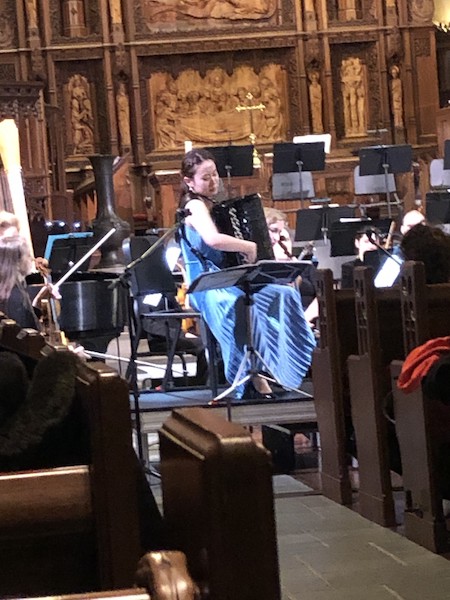by Kevin McLaughlin

The Symphony in D by Juan Crisóstomo Arriaga, written in 1825 when the composer was just seventeen, is cast in the Haydn-Mozart mold. The performance revealed a deftly crafted work — exciting, tuneful, and blustery. After the Haydnesque slow introduction that prepares the listener for a D-major Allegro, the orchestra leaned into the unexpected d-minor with stormy energy and dynamic contrasts. Meyer kept fast tempos under control, battling acoustically challenging circumstances — distinctions of timbre and precision of attacks were frequently lost in the cavernous space.
The second movement, Andante, was a sunnier affair. The BlueWater strings demonstrated their usual warm sound with a melody reminiscent of Schubert. The third movement, a boisterous scherzo with the triple meter occasionally reorganized into duple, was synchronous and light, with graceful solos from principal flute Sean Gabriel in the central trio. The final movement, the most kinetic of the four, raced along ominously in minor before turning joyful at the end, aided by timpani and trumpets.
Arriaga died ten days before his 20th birthday of a lung ailment (possibly tuberculosis), or exhaustion, perhaps both. The Symphony in D is an auspicious opus, making one glad of its existence and rueful for the state of health care in the 1820s.
The Three Latin American Sketches of Aaron Copland gave the program its lodestar and reminded everyone what a knack Copland had for producing Latin-sounding tunes. Meyer’s introduction included the nugget that Copland composed two of the movements, “Paisaje Mexicano” and “Danza de Jalisco,” in Acapulco in 1959, with “Estribillo” being written in 1972 for the New York Philharmonic to complete the set. BlueWater presented a vivid and cleanly articulated rendition, with principal trumpet David Duro sounding splendid during his solos in “Paisaje Mexicano.”
Playing a large, concert button accordion, whose bellows-like operation is endlessly fascinating to the average onlooker, Hanzhi Wang commanded attention from the moment she took the stage for Astor Piazzolla’s Bandoneon Concerto, titled Aconcagua.
In the opening Allegro Marcato, a stabbing, indomitable tango, Wang and the orchestra offered rhythm and heat. This music is not for the faint of heart. Even an unfortunate restart, owing to amplification difficulties (or acoustical?), could not break the spell of the soloist’s indomitable intent. Wang’s hands blurred in their flight but obviously knew what to do, and her rhythm was steely and precise. Indeed, both soloist and orchestra demonstrated a reliable rhythmic sense, proving themselves to be good dance partners. How fun it might have been for the orchestra to don a looser, outdoor-street-band-style approach (standing up in a semi-circle for example, or using amplification). The percussionists seemed to agree, supplying much needed Carnival character.
The second movement, eliciting an introspective solo cadenza, led to a hard-driving Presto, similar in feel to the first movement, but if possible, with even more excitement from the soloist. The Melancolico Final was an unexpected wistful interlude before orchestra and soloist joined for one last trip around the dance floor.
Published on ClevelandClassical.com March 14, 2023.
Click here for a printable copy of this article



